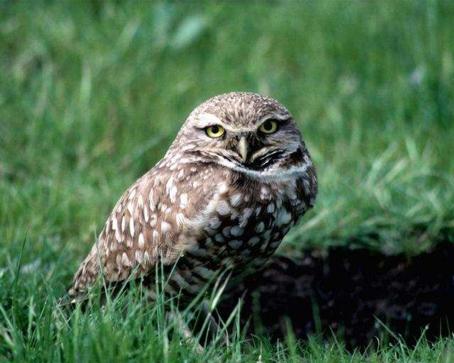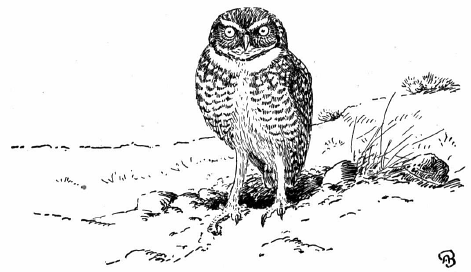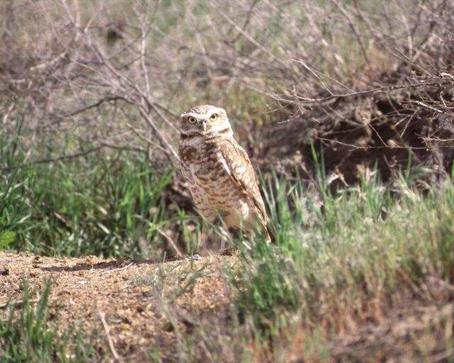All About Small Owls
Owls are fascinating creatures that are well-known for their silent flight, unique appearance, and impressive hunting skills. While most people might picture the majestic great horned owl or the wise-looking snowy owl, there are also many species of small owls that are just as interesting and deserving of attention. Despite their small size, these tiny owls are full of personality and have adapted to survive in a variety of environments. In this blog, we will explore the world of small owls, their unique features, and what makes them so special. From the elf owl of the desert to the pygmy owl of the forest, get ready to discover some of the most fascinating small owls in the world!
Why Do Burrowing Owls Having Long Legs?
Burrowing Owl (Athene cunicularia) 8 inches long

Why Do Burrowing Owls Having Long Legs?
Burrowing owls have long legs because they are adapted to their habitat and lifestyle. They live in open grasslands, deserts, and agricultural areas where they nest in burrows that they either dig themselves or take over from other animals such as prairie dogs. Their long legs enable them to move quickly and easily through tall grasses, as well as to stand tall and see over the grasses to look for predators or prey.
Their long legs also allow them to move quickly and easily through the tunnels and burrows that they use for nesting and shelter. They are able to run, jump, and climb in these confined spaces, which gives them an advantage over other predators that may try to invade their nests.
Additionally, burrowing owls are active during the day and often hunt small prey such as insects, rodents, and lizards. Their long legs allow them to make quick, agile movements to catch these fast-moving prey.
In summary, burrowing owls have long legs as an adaptation to their habitat and lifestyle, which includes living in open grasslands, nesting in burrows, and hunting small prey.
Where Do Burrowing Owls Live?
This unusual ground-dwelling owl favors open country–grassland, prairie, farmland and airfields. Cowboys called it the “howdy bird” on account of its habit of giving a little bowing curtsey as if it were saying “howdy!” It is often active during the day, though it does most of its hunting at dusk and during the night. In summer it eats mostly large insects such as grasshoppers and crickets as well as scorpions, centipedes and other arthropods. During the winter, when these insects are scarce, it switches to small mammals such as voles, mice and ground squirrels.

Field marks to look for include long legs, white “eyebrows,” yellow eyes and bill, brown upperparts with white spots on the back and wings. The chest is dark with white spots, white belly with brown barring. No other owl is so long-legged, and no other owl is found in the same habitat. They make their home in a burrow, often one formerly used by prairie dogs, ground squirrels, kangaroo rats or other animals. Their burrows may be as long as 6-10 feet, and the nest is within the burrow where the female stays with the young while the male brings them food. The young leave the nest at about 6 weeks of age. These birds may be year-round residents in southeast Arizona or may migrate south to Mexico during cold seasons.
Where Can I See a Burrowing Owl?

If you would like to see Burrowing Owls, a good place to look is in Tucson at the Kino Ecosystem Restoration Project (KERP) near the lighted Kino Sports Complex at Ajo and Country Club Road in Tucson. This 141-acre site is just off the freeway, and you can park in the sports complex parking lot and walk the slightly-over-2-mile perimeter trail. There are riparian areas, mesquite bosques, creosote and grassland in this restored native habitat for urban wildlife. Displaced Burrowing Owls from the area are released at the KERP which provides numerous Burrowing Owl nesting tunnels. You may also see desert cottontails, black-tailed jackrabbit, Red-tailed Hawk, and Gambel’s Quail. The Tucson Audubon Society leads monthly bird walks here on the fourth Saturday of each month. For information and a map of the trail go here.
What Sound Does a Burrowing Owl Make?
Burrowing owls make a variety of sounds that are unique to their species. One of their most distinctive vocalizations is a series of cooing or “chuckling” calls, which sounds like a soft, low-pitched “coo-coo-coo”. They often make these calls when they are communicating with other owls, especially during the breeding season.
In addition to the cooing calls, burrowing owls also make hissing or “snake-like” sounds when they feel threatened or are defending their nest. They may also make clicking sounds with their beaks or clack their bills together as a warning to potential predators.
During the breeding season, male burrowing owls may also perform a “sky dance” display in which they fly in a circular pattern while making a series of vocalizations that sound like a high-pitched whistle or trill.
Overall, burrowing owls have a range of unique and interesting vocalizations that are an important part of their communication and behavior.
How Do I Get Rid of Burrowing Owls?
It is important to note that burrowing owls are protected by law in many areas and it may be illegal to remove them or disturb their burrows. Therefore, it is recommended to contact a local wildlife agency or professional for guidance on how to handle any issues related to burrowing owls.
If you are experiencing problems with burrowing owls on your property, here are some steps you can take:
- Modify your landscaping: Burrowing owls are attracted to open, flat areas with short grass. By altering the landscaping to include taller vegetation, shrubs, and trees, you can make the area less attractive to the owls.
- Install barriers: You can install barriers such as fencing, netting, or wire mesh around the perimeter of your property to prevent the owls from entering.
- Use deterrents: There are various deterrents that can be used to discourage burrowing owls from nesting or roosting on your property. For example, you can use decoys, reflective tape, or noise-making devices.
- Seek professional assistance: If the problem persists, it may be necessary to seek the assistance of a licensed professional wildlife removal company or a wildlife biologist.
It is important to remember that burrowing owls are an important part of the ecosystem and play a valuable role in controlling rodent populations. Therefore, it is best to try to coexist with them whenever possible and take steps to prevent conflicts rather than resorting to removal or relocation.
Elf Owl
Elf owls are fascinating creatures and there are many great things about them! Here are some of the most notable features and characteristics of these small but mighty birds:
- Size: Elf owls are the smallest owl species in the world, measuring just 5-6 inches tall and weighing only 1-2 ounces. This makes them a unique and interesting species to observe.
- Adaptability: Despite their small size, elf owls are able to adapt to a wide range of habitats, including desert, woodland, and scrubland areas.
- Vocalizations: Elf owls are known for their distinctive vocalizations, including a series of high-pitched whistles, trills, and chattering sounds. They use these calls to communicate with other owls and establish their territory.
- Unique hunting style: Elf owls have a unique hunting style where they perch on a tree branch or other elevated location and swoop down to catch prey on the ground. This allows them to hunt for insects and other small invertebrates that other owl species might not be able to catch.
- Importance to the ecosystem: As predators of insects and small invertebrates, elf owls play an important role in controlling pest populations and maintaining a healthy ecosystem.
Overall, elf owls are fascinating creatures that are well adapted to their environment and have a unique set of characteristics and behaviors that make them a truly special species to observe and appreciate.
 This tiny owl, hardly bigger than a sparrow, is the smallest owl in the world. It inhabits saguaro deserts and wooded canyons. It feeds by night, mainly on insects and other arthropods including scorpions and spiders. It has a large, rounded head, yellow eyes and brown upperparts with white spots, brown and gray breast with white belly. Somewhat rare in the U.S. (probably because of loss of habitat), it inhabits the Mexican border area of Arizona. Since it feeds mainly on insects, which are unavailable in winter, it is strictly a summer resident north of the Mexican border, arriving early in spring and departing fairly early in fall. Also shown in the drawing is the Sonoran whipsnake; the drawing is from The Sonoran Desert by Day and Night by Dot Barlowe, referenced below.
This tiny owl, hardly bigger than a sparrow, is the smallest owl in the world. It inhabits saguaro deserts and wooded canyons. It feeds by night, mainly on insects and other arthropods including scorpions and spiders. It has a large, rounded head, yellow eyes and brown upperparts with white spots, brown and gray breast with white belly. Somewhat rare in the U.S. (probably because of loss of habitat), it inhabits the Mexican border area of Arizona. Since it feeds mainly on insects, which are unavailable in winter, it is strictly a summer resident north of the Mexican border, arriving early in spring and departing fairly early in fall. Also shown in the drawing is the Sonoran whipsnake; the drawing is from The Sonoran Desert by Day and Night by Dot Barlowe, referenced below.
What Do Elf Owls Eat?
Elf owls primarily feed on insects and other small invertebrates. Their diet consists of a variety of insects such as beetles, moths, crickets, grasshoppers, and spiders. They also eat scorpions and occasionally small lizards.
Being a small owl species, elf owls have adapted to hunting smaller prey that other owl species might not be able to catch. They are nocturnal hunters and use their keen eyesight and hearing to locate prey in the darkness. They also have a unique hunting strategy where they will perch on a tree branch or other elevated location and swoop down to catch prey on the ground.
While insects make up the majority of their diet, elf owls have been known to occasionally eat small rodents and birds if they are available.
Overall, the diet of the elf owl is specialized to their small size and unique hunting habits, consisting mostly of insects and other small invertebrates.
References:
Alderfer, Jonathan (ed.). National Geographic Field Guide to Birds: Arizona/New Mexico . Washington, D.C.: National Geographic, 2006. This handy, really pocket-size (4×6) guide includes most of the birds you’re likely to see in Arizona. In addition to a photo, it includes information about behavior, habitat and specific local sites where you are likely to find the bird.
Western Screech Owl

Western Screech Owl, USFWS photo by Jim Rorabaugh
Western Screech Owls are a remarkable species of owl found in the western part of North America. Here are some of the things that make these owls great:
- Unique Appearance: Western Screech Owls have a distinctive appearance with their small size, yellow eyes, and ear tufts. They have a stocky build and can range in color from gray to brown to reddish-brown.
- Adaptable: These owls are adaptable to a wide range of habitats, including forests, woodlands, deserts, and suburban areas. They are able to adjust their hunting strategies and diet depending on their environment.
- Vocalizations: Western Screech Owls have a variety of vocalizations, including a soft trilling call and a series of whistles and hoots. They use these calls to communicate with other owls and establish their territory.
- Predator Control: As predators of small mammals, birds, and insects, Western Screech Owls help to control pest populations and maintain a healthy ecosystem.
- Importance to Native Cultures: These owls are important to many Native American cultures, who view them as spiritual beings and symbols of wisdom and knowledge.
Overall, Western Screech Owls are a fascinating and important species that play a critical role in maintaining the health of ecosystems in their range. They are also culturally significant and have a unique set of adaptations and characteristics that make them a joy to observe and appreciate.
The Western Screech Owl is gray in color overall with blackish streaks and bars. Its eyes are yellow. This well-camouflaged little owl is more often heard than seen. Its call is a series of short, accelerating whistles. A nocturnal hunter, it preys principally on small rodents, small birds and insects, which it catches by swooping down from a lofty perch. It is a fairly common year-round resident in most of Arizona and New Mexico, particularly favoring open woodlands, riparian groves, suburbs and parks.
 A closely related species, the Whiskered Screech Owl (Otus trichopsis) is somewhat smaller at 7.25 inches long. It occurs in extreme southeast Arizona as an extension of its Mexican range. Like the western screech owl it is found in open woods at forest edges hunting rodents and insects. The two species are generally differentiated by their call. USFWS photo by Gary M. Stolz
A closely related species, the Whiskered Screech Owl (Otus trichopsis) is somewhat smaller at 7.25 inches long. It occurs in extreme southeast Arizona as an extension of its Mexican range. Like the western screech owl it is found in open woods at forest edges hunting rodents and insects. The two species are generally differentiated by their call. USFWS photo by Gary M. Stolz
Do Owls Hibernate in the Winter?
Owls do not hibernate in the winter. Instead, they have evolved various adaptations to survive the cold and harsh winter conditions. One of the most important adaptations is their ability to tolerate the cold by fluffing up their feathers, which creates a layer of air insulation around their body. This helps to trap heat and keep them warm in cold temperatures. Additionally, owls have a higher metabolic rate, which allows them to generate more body heat to stay warm.
During the winter months, some owl species may migrate to warmer areas, while others may stay in their territories and hunt for food in the snow-covered landscape. Owls are opportunistic hunters and will eat a variety of prey, including rodents, small mammals, birds, and fish, which they can find even in the winter.
In summary, while owls do not hibernate in the winter, they have evolved various adaptations to survive the cold and harsh winter conditions. They are able to tolerate the cold by fluffing up their feathers and generating more body heat, and they will continue to hunt and feed on a variety of prey, even in the snow-covered landscape.
Like this article? Maybe you’ll enjoy Animals That Went Extinct in 2022